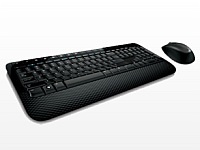Review: Microsoft Wireless Desktop 2000 | TechTree.com
Review: Microsoft Wireless Desktop 2000
Good hardware, bad design.

Excellent BlueTrack sensor; Silent, short-throw membrane keys; Great operational range; No interference; Virtually lag-free; Wide range of Windows optimised function keys; Jitter-free mouse; Wristpad; 6-key rollover; Great value for money.
Crazy scroll wheel; Unergonomic; Lacks proper key spacing; No indicators for toggle keys; Requires a steep learning curve.
Microsoft Wireless Desktop 2000
MRP: Rs 1450
Street Price (As On 28-Oct-2011): Rs 1400 (Flipkart.com)
Not too long ago, wireless keyboards meant interference, line-of-sight issues, unbearable input lag, battery woes, and generally a frustrating experience that forced many to revert to the wired ways. Most of these issues have been dealt with, thanks to 2.4 GHz wireless technology, but input lag still remains the Achilles heel even on expensive wireless gaming mice. However, the latest entrant from Microsoft claims to solve all these problems without hurting your wallet. That's a tall task indeed. Therefore, I decided to put the Microsoft Wireless Desktop 2000 (WD2000) through the paces to verify the claim.

The mouse disappoints in the ergonomics department.
The Bundle
The WD2000 looks and feels like any entry-level wireless combo. For the price, you get an average-sized mouse replete with a power switch, two buttons, tilt-wheel for sideways scrolling, and a battery compartment that houses two AA batteries. The keyboard is powered by two AAA batteries. It sports a low battery indicator that lights up green at startup to indicate healthy batteries. Thereafter, it remains switched off until the battery is about to croak, which it signals with a continuous red light.
It would be a folly to expect a nano receiver at this price range. The wireless bundle features a rather large and unwieldy USB receiver that will stick out of your laptop like a 2.4 GHz radiation emitting tumour. However, I have no complaints since it works flawlessly. I found zero interference issues, despite the rodent's proximity to my wireless router and a 2.4 GHz R\C car in operation. Both the keyboard and mouse operated glitch-free from every nook and cranny in the room without any line-of-sight issues. When powered off, the dongle can be tucked either in a cavity next to the keyboard's battery compartment, or slotted into the bottom of the mouse.

The BlueTrack sensor can track absolutely anywhere, save clear glass and mirrors.
BlueTrack Hits The Spot
The mouse alone is well worth the price of the entire combo. Microsoft Research has been responsible for a lot of downright amazing innovations, most of which have incredulously been ignored. However, the BlueTrack optical sensor has somehow made it through the red tape and into this humble mouse. This little puppy does what the best laser \ infrared dual-sensor equipped gaming mice cannot - that is, work on any damn surface you throw at it.
While you have to mix and match other mice with expensive mouse mats for optimum tracking, that isn't the case with the BlueTrack sensor. I have used the WD2000 mouse on my mouse pad, over the table, under it, on the floor, on my lap, my cheek, on top of my head, on tinted window panes, and on my neighbour's pet cat - the mouse delivers perfect tracking in every single instance.
What's more, the budget mouse doesn't skip or even show much jitter during finer manoeuvres. Input lag is virtually non-existent, and this makes it good enough for gaming. This is something even most wireless gaming mice cannot boast of. While it's not a patch on my recently-deceased DeathAdder for pixel-precise accuracy, this is a barebones wireless mouse that performs with the competence of a good wired counterpart.

Free Wheely: The scroll wheel seems to have a mind of its own.
Unfortunately, the ergonomics leave a lot of be desired. The mouse is a tad too heavy for my tastes, but those with shaky hands will appreciate the dampening offered by the extra weight. The palm support is too narrow, while the lack of angle at the front makes your middle finger rest uncomfortably on the edge of the scroll wheel, instead of the right button. It almost seems like the designers deliberately made the mouse less ergonomic to justify its budget leanings.
For me, the deal-breaker in this rodent's long list of design follies has to be the ultra-sensitive mouse wheel. I can't fathom what logic Microsoft engineers used when they seemingly mounted the wheel on a ceramic bearing. Mouse wheels need dampening to prevent accidental scrolling, which is a major problem with this mouse. Just hitting the desk with your fist will make the mouse scroll a webpage inadvertently. Accurate middle-clicks, which are the norm to open links in new tabs, require superhuman dexterity. However, the silk-smooth tracking and lightning-quick response will make you disregard the poorly-designed outer shell.
Competent Hardware Ruined By Bad Design
The keyboard offers a great deal of features at this price range. It has a lot of love for Windows 7 and Microsoft Office, which it demonstrates by including a plethora of dedicated keys. The top row is populated with one-touch keys meant for the Browser, E-mail, Favourites, Magnification, and Calculator, as well as discrete controls for media players and system volume. The function keys are shrunk vertically and feature alternate functions such as Undo, Redo, Open and Close files, Spellcheck, Save, Print, and other shortcuts optimised for MS Office. These alternate tasks can be deployed by the means of a function key found on the left of the space bar.

A lack of spacing between the key clusters is potentially disorienting.
The top half of the wireless keyboard sports a piano black finish that tends to attract smudges and fingerprints, while the bottom half bears an extended matte plastic wrist pad that is claimed to be "pillow textured". The reference to pillows ends at texturing, because the plastic wrist pad is just as hard as the rest of the body. However, credit must be given for incorporating one at this price, even if it's just a hunk of extra plastic.
The build quality is pretty good for this segment. The plastic chassis is sturdy, although it does show a hint of trampolining (a slight bending in the middle of the keyboard chassis when pressed upon) - the bane of all keyboards incorporating plastic construction. The rubber bushing at the bottom is sufficient to anchor the keyboard securely, while the flip-out tabs, meant to angle the keyboard at a comfortable typing position, are massive and sturdy enough to take a great deal of abuse.
The keys employ familiar membrane-based polydome switches, but they are delightfully short-throw - so much so that it almost had me believing that Microsoft had used scissor switches instead. The WD2000's keys are higher quality, short-throw polydome switches that have a remarkably negligible play and a linear, noiseless operation. The keys are a bit harder than the average keyboard, which shouldn't be a problem once they have been broken in properly.

The wireless dongle can be stowed away next to the battery compartment.
Not only does the keyboard provide a great tactile feel, but it supports 6-key rollover, which I verified with this utility. The keyboard doesn't skimp on the hardware aspect, including better circuit design - and most probably diodes in the circuit - to optimise the keyboard control matrix. I managed to press six keys at a time, with the exception of the ZXC and arrow key clusters, which is on par with most gaming keyboards that boast of 6-key rollover. I tried out all the possible permutations and combinations of multiple key inputs required for gaming, and the keyboard stood its ground in all the tests.
Despite such good showing, the designers at Microsoft decided to ruin the keyboard by removing the spacing generally found between the numpad, arrow keys, and the ins-del-home-end-pgup-pgdn clusters. This is a serious problem when you want to hit [BACKSPACE], because you'll end up pressing [INSERT] every single time. While the larger key face feels good, the lack of spacing between the keys is bad news for touch typing. This bizarre design decision will require a steep learning curve. However, once you do get used to this, perhaps it may not be a problem anymore. I say "perhaps", because I still haven't gotten used to it. Finally, the lack of any LED indicators for Num, Caps, and Scroll Lock is a rather confounding omission.
Conclusion
The wireless bundle delivers terrific value at this price range, despite the ergonomics issues. Beneath the poorly-designed exterior, you have a blindingly competent track-anywhere mouse and a 6-key rollover keyboard, with great tactile feedback and noiseless operation. In essence, you get excellent hardware marred by poor design for Rs 1400. However, these hurdles can be overcome with some practise. If you are willing to brave that aspect, the Microsoft Wireless Desktop 2000 bundle is definitely worth buying.
Performance: 4/5
Design And Build Quality: 2/5
Features: 4/5
Value: 4.5/5
Mojo: 3.5/5
Overall Rating: 3.5/5
TAGS: Input Devices, Microsoft, Nachiket
- DRIFE Begins Operations in Namma Bengaluru
- Sevenaire launches ‘NEPTUNE’ – 24W Portable Speaker with RGB LED Lights
- Inbase launches ‘Urban Q1 Pro’ TWS Earbuds with Smart Touch control in India
- Airtel announces Rs 6000 cashback on purchase of smartphones from leading brands
- 78% of Indians are saving to spend during the festive season and 72% will splurge on gadgets & electronics
- 5 Tips For Buying A TV This Festive Season
- Facebook launches its largest creator education program in India
- 5 educational tech toys for young and aspiring engineers
- Mid-range smartphones emerge as customer favourites this festive season, reveals Amazon survey
- COLORFUL Launches Onebot M24A1 AIO PC for Professionals







TECHTREE